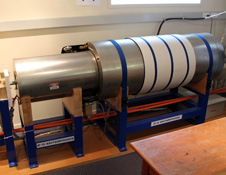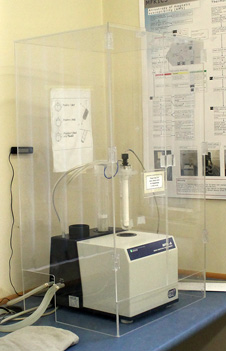Motivation behind the Otago Paleomagnetic Research facility
Paleomagnetism is the study of the strength and direction of Earth's magnetic field recorded by ferromagnetic minerals in rocks and sediments. These records can be used as a relative dating method. Ferromagnetic minerals (their grain-size, concentration and mineralogy) can also be used as proxies for environmental change—on land and in the ocean. Global earth and climate systems impact the way we live, and we need to understand how they work. New Zealand's unique geological evolution offers important insight into these natural earth and climate systems, providing significant archives—both long and short-term. The challenge facing geologists is to interpret these records on a time scale that means something to us, and to work out which intervals of the archive are most relevant to the specific problems we face.
Equipment in the facility
 Cryogenic magnetometer in the Department of Geology
Cryogenic magnetometer in the Department of Geology
The focus of the facility is a state-of-the-art cryogenic (or supercooled) rock magnetometer—one of the most sensitive of its kind in the world. It is housed in a 30 cubic metre magnetically shielded room. Two tonnes of high silicone transformer steel are hung in two independent shields on a non-magnetic frame resulting in an internal field of 150 nanotesla - less than 0.25% of Earth's surrounding magnetic field. This enables rock and sediment samples to be analysed without interference.
The cryogenic magnetometer is a long core system, enabling 1.5 metre long sediment cores to be analysed, as well as individual paleomagnetic samples, making it ideal for marine, lake and land-based work.
 MFK1-A Kappabridge in the Department of Geology
MFK1-A Kappabridge in the Department of Geology
The cryogenic magnetometer also has in-line AF demagnetisation, magnetic susceptibility and anhysteretic remanent magnetism capabilities. The lab also houses a fluxgate magnetometer, an ASC Thermal demagnetiser, and ASC impulse magnetiser, a Bartington single sample susceptibility bridge, a LakeShore Cryotronics Micromag Vibrating Sample Magnetometer, and an AGICO MFK1-A Kappabridge with 3-D rotator. Most instruments are networked into a central computer server that provides common access for different computer platforms and data analysis packages. A cross-platform palaeomagnetic analysis and plotting software, Puffin Plot, was developed in-house.
The laboratory also has a collection of field sampling equipment and shields.
The construction of the facility was funded by grants from the University of Otago Research Equipment Committee and the Institute of Geological and Nuclear Sciences (http://www.gns.cri.nz). Research has been funded by the Ministry of Business, Innovation and Employment (MBIE) Antarctic Science Platform, The New Zealand Antarctic Research Institute (NZARI), The Marsden Fund (Royal Society of New Zealand), University of Otago Research Grants and others.
